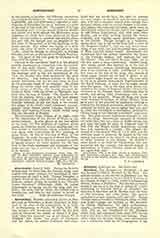

Aberdeen, the Diocese of (Scotland).—A see was founded in 1063 at Mortlach by Bl. Beyn. The earliest mention of the old See of Aberdeen is in the charter of the foundation, by the Earl of Buchan, of the Church of Deer (c. 1152), which is witnessed by Nectan, Bishop of Aberdeen. But the first authentic record of the see is in the Bull of Adrian IV (1157), confirming to Edward, Bishop of Aberdeen, the churches of Aberdeen and St. Machar, with the town of Old Aberdeen and other lands. The granite cathedral was built between 1272 and 1277. Bishop Thomas Spence founded a Franciscan house in 1480, and King’s College was founded at Old Aberdeen by Bishop Elphinstone, for eight prebendaries, chapter, sacristan, organist, and six choristers, in 1505. The see was transferred to Old Aberdeen about 1125, and continued there until 1577, having had in that time a list of twenty-nine bishops. From 1653, when the Scottish clergy were incorporated into a missionary body by the Congregation of the Propaganda, until 1695, the Catholics of Scotland were governed by prefects-apostolic. Then followed vicars-apostolic until March 4, 1878, when Leo XIII, in the first year of his pontificate, restored the hierarchy of Scotland by the Bull “Ex supremo Apostolatus apice”, and Vicar-Apostolic John MacDonald was translated to the restored See of Aberdeen as its first bishop.
The Bull made Aberdeen one of the four suffragan sees of the Archbishopric of St. Andrews and Edinburgh, and defined as its territory” the counties of Aberdeen, Kincardine, Banff, Elgin or Moray, Nairn, Ross (except Lewis in the Hebrides), Cromarty, Sutherland, Caithness, the Orkney and Shetland Islands, and that portion of Inverness which lies to the north of a straight line drawn from the most northerly point of Loch Luing to the eastern boundary of the said county of Inverness, where the counties of Aberdeen and Banff join”. In 1906, out of a population of over 800,000 there were nearly 4,000 Catholics; 48 secular priests; 24 regulars; 57 churches, chapels, and stations; 1 college; 1 industrial school for girls; 1 orphanage for boys; 1 orphanage for girls, There are also Benedictine nuns, Poor Sisters of Nazareth, Franciscan Sisters, Religious of the Sacred Heart, and Sisters of Mercy. There have been four Bishops of Aberdeen since the restoration, the present incumbent, the Rt. Rev. Aeneas Chisholm, having been consecrated February 24, 1899. There is a Benedictine Abbey at Fort Augustus, at which the restored hierarchy met in a Provincial Council, August, 1886, under the presidency of the Archbishop of St. Andrews, three hundred and twenty-six years after the downfall of the Faith in Scotland. The Provincial Council of March 1, 1559, at Edinburgh, under Archbishop Hamilton, was the last council before this, and that had adjourned after appointing Septuagesima Sunday of 1560, for the next meeting of the synod. Fort Augustus was raised to the rank of an abbey, immediately subject to the Holy See, by a brief of Leo XIII, December 12, 1882. The munificence of Lord Lovat and other liberal benefactors called it into being.

